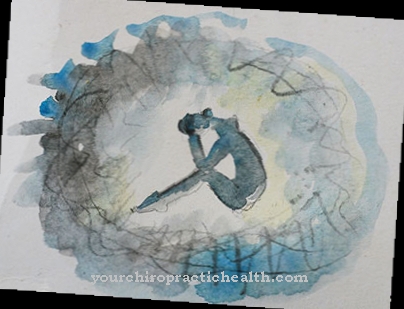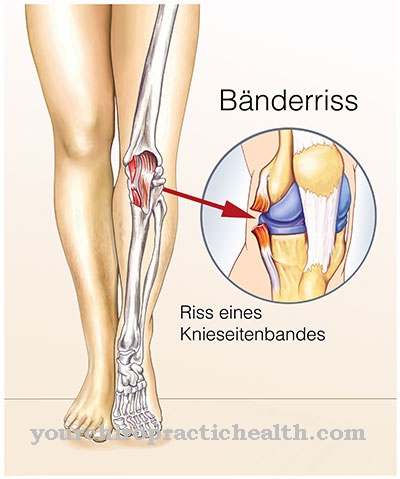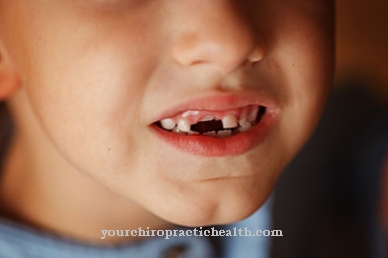If one are especially popular across Germany as Football legs designated. Certainly not completely without reason, because football can promote the visible misalignment of the legs - but this has nothing to do with the ball. Therefore, it is clearly not only footballers who suffer from bowlegs.
What are bow legs?

© nmfotograf - stock.adobe.com
Under Bow legs one basically understands nothing more than a leg position and leg shape that deviates from the physical axis norm. This is why bow-legs in medicine and in technical jargon also count among the so-called axis misalignments.
But what does that mean? That means nothing more than that the legs each run outwards at a more or less drastic angle. Usually the legs should be very straight to each other. The knock knees are a very similar deviation. The bow legs get their name from the fact that an oval or even round recess is created between the legs, depending on how severe the deformity is.
causes
Causes can If one show very many. For one, the deformation of the legs can be congenital. This is usually noticeable in early childhood. The problem here, however, is that initial deformations of the legs as they grow are absolutely not uncommon.
The majority of children suffer from bow-legs or knock-knees at a very young age. In about 70 percent of cases, the malpositions correct themselves as the growth progresses.
Other reasons could also be broken bones, the effects of paralysis, diseases such as rickets and osteoporosis, or severe obesity and overloading of the legs caused by exercise.
Symptoms, ailments & signs
The symptoms of bow legs are limited to the musculoskeletal system. They affect the legs, feet and, in some cases, the back and spine. In many cases, however, people with slightly bowlegs have no symptoms at all and do not develop excessive signs of wear and tear due to the deformities even in old age.
Primarily pain can occur. These are particularly noticeable on the knees. The insides of the knees are particularly stressed. The pain can also radiate. The pain usually increases with exercise. They are stronger after getting up in the morning than during the day. The pain can be aggravated by pulling or pushing.
The bow legs also increase joint wear, which can promote osteoarthritis. As the process progresses, the feet may be misaligned and so-called bent or flat feet. These can reduce the resilience of the ankles and feet in general.
If only one leg is affected by the misalignment, the spine is involved and corresponding back pain occurs. The hip may shift as a result of an adjustment. Signs of bowlegs are sciatica, the typical gait and - less often - headache. Most of the time, the symptoms appear as early as childhood.
Diagnosis & course
Depending on how strong the deformations and misalignments are, can If one recognize at a first glance. However, the typical symptoms, such as pain and movement disorders, do not always have to be associated with the diagnosis. Many people live their entire life with bow legs without ever feeling any serious discomfort.
Nevertheless, one should not completely underestimate the risks of bowlegs. Because the articular cartilage wears out faster here under certain circumstances, there can be an increased risk of osteoarthritis in old age. If complaints occur, which is especially the case if the misalignment is very severe or not congenital, but occurs “suddenly”, various examinations can determine the degree and cause of the misalignment. The best examples of this are x-rays and special running analyzes.
Complications
Because of the bow legs, those affected sometimes suffer from severe pain. This can also lead to significant restrictions at work or in everyday life, so that the patient may no longer be able to carry out his activity. However, the bow legs do not always lead to complications.
It is not uncommon for patients to live with their bow legs for a lifetime and feel no particular discomfort. Due to the bow legs, however, the risk of osteoarthritis in the joints can be significantly increased, so that those affected usually depend on regular examinations to avoid this complication. A misalignment of the legs can also occur and have a very negative effect on the patient's everyday life.
As a rule, direct treatment of the bow legs is not necessary in children. This deformity usually disappears on its own with adulthood. In severe cases, however, surgical interventions are necessary to alleviate the symptoms. The treatment itself can last for several years. The life expectancy of the patient is not negatively influenced by the bow legs.
When should you go to the doctor?
From a medical point of view, bow legs are not a reason for medical treatment. It is a visual flaw that has no disease value. A visit to the doctor is therefore usually not necessary. If severe deformations of the skeletal system are noticed during the growth and development process of the offspring, they can be discussed with a doctor during a check-up. In the event of restricted mobility or pain while moving, a doctor's visit is necessary to clarify the cause.
Abnormal gait, limping or pelvic inclination should be examined. Corrective measures are indicated if necessary. On the other hand, people with bow-legged legs who can move about without symptoms in everyday life do not need medical help. If the visual changes lead to mental or emotional irregularities, a visit to a doctor or therapist is recommended. Mood swings, depressed mood or loss of wellbeing should be discussed.
If there is a withdrawal from social life or a refusal to participate in usual sporting activities, a doctor should be consulted. Personality changes, persistent sadness, abdominal pain, malaise, insomnia or headaches can be signs of psychological distress and must be presented to a doctor if they persist for several days or weeks. If a feeling of illness sets in, it is also advisable to consult a doctor.
Treatment & Therapy
How to treat Bow legs looks like depends primarily on the severity of the deformation and also on the age of the patient. In most cases, no special therapy is necessary for children, as the deformity often grows together over the years.
To be on the safe side, you can get to the bottom of any bad posture now. If these are present, this can result in further and permanent deformation of the legs. If bow legs occur in old age, the procedure is similar. If the misalignment is not too drastic, it can be counteracted slowly and carefully with special shoe soles, orthopedic shoes.
Of course, the treatment can take several months or even years. Surgical interventions are faster and more effective. However, these are actually only used for severe and severely pathological malpositions. And: If there is an underlying disease, it must be treated first.
Outlook & forecast
The natural course of a malalignment of the knee joint cannot be precisely predicted. One possible long-term consequence is premature osteoarthritis of the knee joint. Since the inner area of the joint experiences greater stress with a bow-leg, this area is more worn. In addition, the inner meniscus is overstrained, which can lead to medial osteoarthritis of the knee. Above all, the inner joint bone of the thigh bone is damaged. This can lead to pain in the patient and, in severe cases, limit mobility. In these cases, a knee joint prosthesis may be necessary to alleviate the symptoms. In other cases, however, those affected do not notice any consequential damage even after years.
Even if osteoarthritis of the knee is considered a possible complication, its probability cannot be predicted. There is also no scientific prognosis as to how the extent of the deformity of the knee joint will affect the likelihood of osteoarthritis. Despite an operative leg axis correction, there is theoretically still the possibility of osteoarthritis. However, the proportion of those affected with knee joint prostheses 10 years after surgery is only 25%. Surgical therapy is not always necessary, so that consequential damage can also be specifically prevented with orthopedic means.
prevention
You can only prevent bow legs to a very limited extent. With children you should always make sure that they do not develop posture disorders. You should also always make sure that children do not have to struggle with excessively overweight at too young a age. The same naturally applies to those affected in adulthood. Otherwise you can only pay attention to your own posture and act as quickly as possible when the first signs of bowlegs appear.
Aftercare
Follow-up care of the bow leg is necessary if there are symptoms due to a surgical procedure such as an osteotomy. After the operation, the patient has to spend another four to five days in the hospital. If more swelling occurs, the inpatient stay will be extended.
A full load on the operated leg may only take place when the healing of the bone can be proven by an X-ray examination. However, partial loads are allowed. The patient uses walking aids such as crutches for about six weeks. Thanks to a newly used angle-stable plate system, he can usually start again with full loads after two to three weeks.
Various physiotherapeutic treatments are carried out in order to advance the course of recovery. These include physiotherapy, lymphatic drainage, kyrotherapy or manual therapy. From the 3rd to 4th week, the patient can also do aqua aerobics such as aqua jogging or crawl swimming or ride a stationary bike. Before discharging the patient, the doctor prescribes tools that can be used at home.
During the follow-up treatment, the patient is regularly given injections that counteract a thrombosis (blood clots). When the operated person can work again depends on his or her profession. Office work can be resumed after about six weeks. Occupations that require physical exertion can take up to three months.
You can do that yourself
In most cases, people with bowlegs do not have any physical health impairments. The musculoskeletal system works symptom-free and a deterioration in the condition is not to be expected.
Nevertheless, bow-legs represent a visual flaw for many people affected. By wearing insoles or special orthopedic shoe soles, a change in the deformation can be achieved under certain conditions in everyday life. With children and adolescents, there is the prospect that the bad posture will grow together in the further growth and development process. Physiotherapy exercises should be carried out to support this. Avoid stresses caused by lifting or carrying heavy objects. In addition, the sports practiced should be checked when performing sporting activities. For some patients, a change in physical activity already leads to an alleviation of the symptoms.
If the bow legs develop in adulthood, chronic diseases are often present. In these cases, the doctor's instructions must be followed so that the symptoms can be minimized and the progression of the disease delayed. If the bow legs were caused by being overweight, the dead weight should be reduced as soon as possible. With sufficient exercise and a healthy and balanced diet, weight can be reduced. In order to maintain good health, it is recommended to regulate body weight according to the guidelines of the BMI.





.jpg)





















